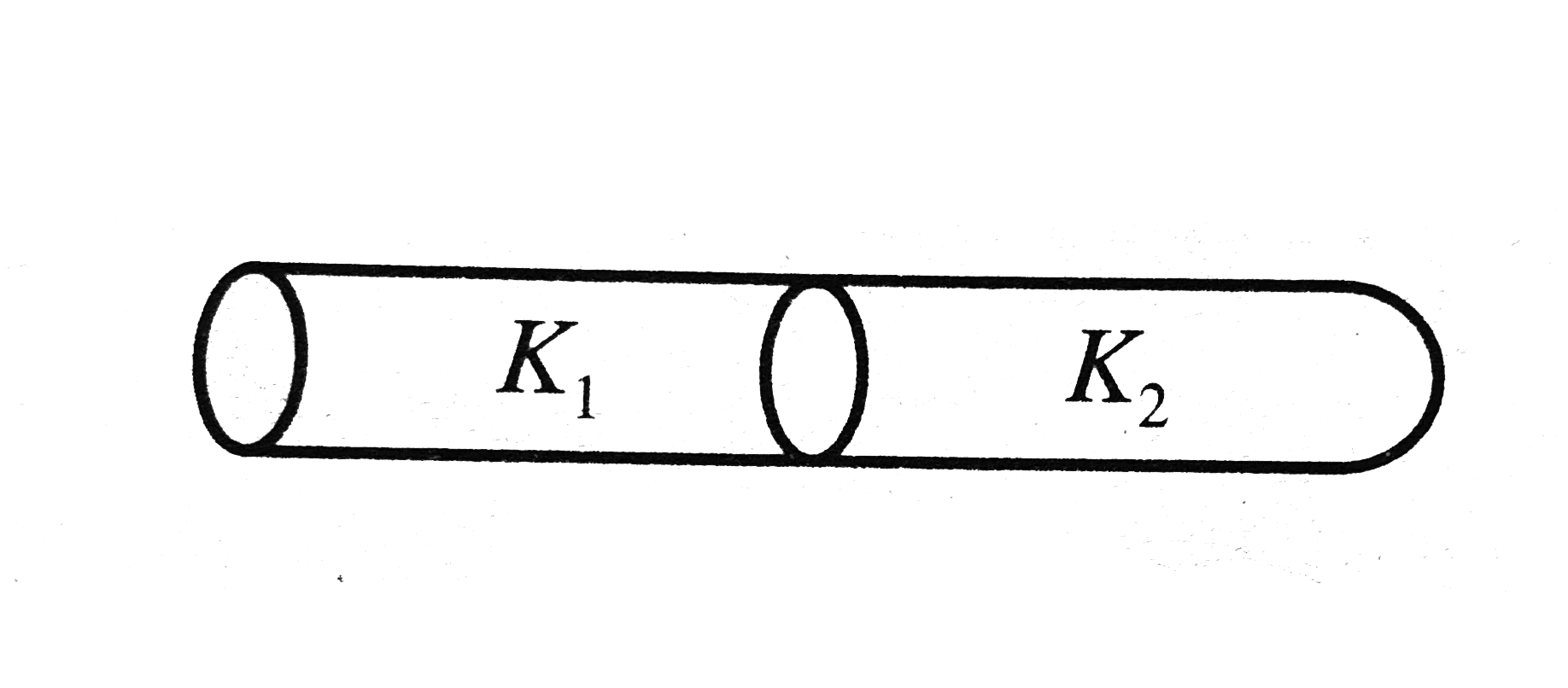A composite slab is made of two parallel layers of two different materials of thermal conductivities K1andK2 are of same thickness. Show that the equivalent thermal conductivity of the slab is 2K1K2K1+K2
To find the equivalent thermal conductivity of a composite slab made of two parallel layers of materials with thermal conductivities K1 and K2 of the same thickness, we can follow these steps:
1. Understand the Setup:
We have two layers of materials, each of thickness L and having the same cross-sectional area A. The thermal conductivities of the materials are K1 and K2.
2. Apply Fourier's Law of Heat Conduction:
According to Fourier's law, the heat transfer Q through a material is given by:
Q=K⋅A⋅ΔTL
where ΔT is the temperature difference across the layer.
3. Heat Transfer Through Each Layer:
For the first layer with conductivity K1:
Q1=K1⋅A⋅ΔTL
For the second layer with conductivity K2:
Q2=K2⋅A⋅ΔTL
4. Assuming Steady-State Conditions:
In steady-state conditions, the heat transfer through both layers must be equal:
Q1=Q2=Q
5. Expressing Heat Transfer:
Since both layers are in parallel, we can express the total heat transfer Q as:
Q=Q1+Q2
6. Relating to Equivalent Conductivity:
The equivalent thermal conductivity Keq of the composite slab can be defined as:
Q=Keq⋅A⋅ΔTL
7. Setting Up the Equation:
From the previous steps, we can set up the equation:
Keq⋅A⋅ΔTL=K1⋅A⋅ΔTL+K2⋅A⋅ΔTL
8. Canceling Common Terms:
Canceling A and ΔT from both sides, we have:
Keq=K1+K2
9. Using the Concept of Resistance:
The thermal resistance R for each layer can be defined as:
R1=LK1⋅A,R2=LK2⋅A
Since the layers are in parallel, the equivalent resistance Req is given by:
1Req=1R1+1R2
10. Substituting for Resistances:
Substituting the expressions for R1 and R2:
1Req=K1⋅AL+K2⋅AL
11. Solving for Keq:
Rearranging gives:
Req=LKeq⋅A=LK1⋅A+LK2⋅A
Thus,
1Keq=1K1+1K2
12. Finding the Equivalent Conductivity:
This leads to:
Keq=2K1K2K1+K2
Final Result:
The equivalent thermal conductivity of the composite slab is:
Keq=2K1K2K1+K2
We have two layers of materials, each of thickness L and having the same cross-sectional area A. The thermal conductivities of the materials are K1 and K2.
According to Fourier's law, the heat transfer Q through a material is given by:
Q=K⋅A⋅ΔTL
where ΔT is the temperature difference across the layer.
For the first layer with conductivity K1:
Q1=K1⋅A⋅ΔTL
For the second layer with conductivity K2:
Q2=K2⋅A⋅ΔTL
In steady-state conditions, the heat transfer through both layers must be equal:
Q1=Q2=Q
Since both layers are in parallel, we can express the total heat transfer Q as:
Q=Q1+Q2
The equivalent thermal conductivity Keq of the composite slab can be defined as:
Q=Keq⋅A⋅ΔTL
From the previous steps, we can set up the equation:
Keq⋅A⋅ΔTL=K1⋅A⋅ΔTL+K2⋅A⋅ΔTL
Canceling A and ΔT from both sides, we have:
Keq=K1+K2
The thermal resistance R for each layer can be defined as:
R1=LK1⋅A,R2=LK2⋅A
Since the layers are in parallel, the equivalent resistance Req is given by:
1Req=1R1+1R2
Substituting the expressions for R1 and R2:
1Req=K1⋅AL+K2⋅AL
Rearranging gives:
Req=LKeq⋅A=LK1⋅A+LK2⋅A
Thus,
1Keq=1K1+1K2
This leads to:
Keq=2K1K2K1+K2
The equivalent thermal conductivity of the composite slab is:
Keq=2K1K2K1+K2
Topper's Solved these Questions
- THERMAL CONDUCTIONBOOK - ICSECHAPTER - THERMAL CONDUCTIONEXERCISE - VERY SHORT ANSWER QUESTIONS
5 Videos
- THERMAL CONDUCTIONBOOK - ICSECHAPTER - THERMAL CONDUCTIONEXERCISE - SELECTED PROBLEMS (Taken from the Previous Years ISC, AISSCE, HSSCE various States. Boards Roorke Qns & NCERT text) FROM RATE OF HEAT FLOW
6 Videos
- THERMAL CONDUCTIONBOOK - ICSECHAPTER - THERMAL CONDUCTIONEXERCISE - LONG ANSWER QUESTIONS
5 Videos
- SELF ASSESSMENT PAPER 5BOOK - ICSECHAPTER - SELF ASSESSMENT PAPER 5EXERCISE - Section-D
6 Videos
- THERMAL RADIATION BOOK - ICSECHAPTER - THERMAL RADIATION EXERCISE - SELECTED PROBLEMS (from WIEN.S DISPLACEMENT LAW)
14 Videos
Similar Questions
Knowledge Check
Consider a compound slab consisting of two different material having equal thickness and thermal conductivities K and 2K respectively. The equivalent thermal conductivity of the slab is
A23KB√2KC3KD43KIF two metallic plates of equal thickness and thermal conductivities K1andK2 are put together face to face anda common plate is constructed, then the equivalent thermal conductivity of this plate will be
AK1K2K1+K2B2K1K2K1+K2C(K21_K22)3/2K1K2D(K21+K22)3/22K1K2
Consider a compound slab consisting of two different material having equal thickness and thermal conductivities K and 2K respectively. The equivalent thermal conductivity of the slab is
View SolutionThree rods of same dimension are joined in series having thermal conductivity k1 , k2 and k3. The equivalent thermal conductivity is
View Solution
Statement I: Two solid cylindrical rods of identical size and different thermal conductivity K1 and K2 are connected in series. Then the equivalent thermal conductivity of two rods system is less than that value of thermal conductivity of either rod.
Statement II: For two cylindrical rods of identical size and different thermal conductivity K1 and K2 connected in series, the equivalent thermal conductivity K is given by 2K=1K1+1K2
View Solution
Statement I: Two solid cylindrical rods of identical size and different thermal conductivity K1 and K2 are connected in series. Then the equivalent thermal conductivity of two rods system is less than that value of thermal conductivity of either rod.
Statement II: For two cylindrical rods of identical size and different thermal conductivity K1 and K2 connected in series, the equivalent thermal conductivity K is given by 2K=1K1+1K2
View SolutionA composite slab is prepared by pasting two plates of thickness L1 and L2 and thermal conductivities K1 and K2 . The slab have equal cross-sectional area. Find the equivalent conductivity of the composite slab.
View SolutionTwo rods A and B of different materials are welded together as shown in figure. Their thermal conductivities are K1 and K2. The thermal conductivity of the composite rod will be

View Solution
